Last updated on July 13th, 2023 at 05:06 pm
Learning the differences between automotive parts is an important aspect of the entire learning experience for novice drivers. In essence, an automated car has two pedals. We’ll go through their main difference in this article.
What Are The Gas Pedal And Brake Pedal Differences?
A significant difference between the gas and brake pedals is that the gas pedal will travel to the floor, while the brake pedal will only stop halfway unless there is a brake failure. Most unexpected acceleration is caused by mistaking one pedal for another or thinking you’re braking.
The accelerator is located on the right side of the car. The brake is located on the left side of the vehicle. Your right foot is used to control both pedals. Your gas pedal effectively provides fuel to your engine, causing it to accelerate. At the same time, your vehicle will be slowed and eventually come to a complete halt if you use the brake pedal.
Functions Of The Gas Pedal And Brake Pedal
The functions of the gas and brake pedals should be balanced appropriately for our car to travel smoothly.
Gas Pedal function
An accelerator pedal is a mechanism that allows a driver to control engine power in various vehicles. It’s the pedal on the far right side of the floor. This pedal regulates the amount of gas supplied into the engine and, as a result, the vehicle’s speed.
Brake Pedal function
The brake system’s primary job is to slow a vehicle down. The brake pads squeeze against the rotor attached to the wheel when you step on the brake pedal, which causes the car to slow down owing to friction.
A braking system absorbs the vehicle’s kinetic energy mechanically or electrically to reduce the vehicle’s speed. Friction transforms kinetic energy into heat in mechanical brakes. A magnet is forced to apply the brakes in electric brakes by an electric current. Causes Of Slight Vibration In Gas Pedal When Accelerating
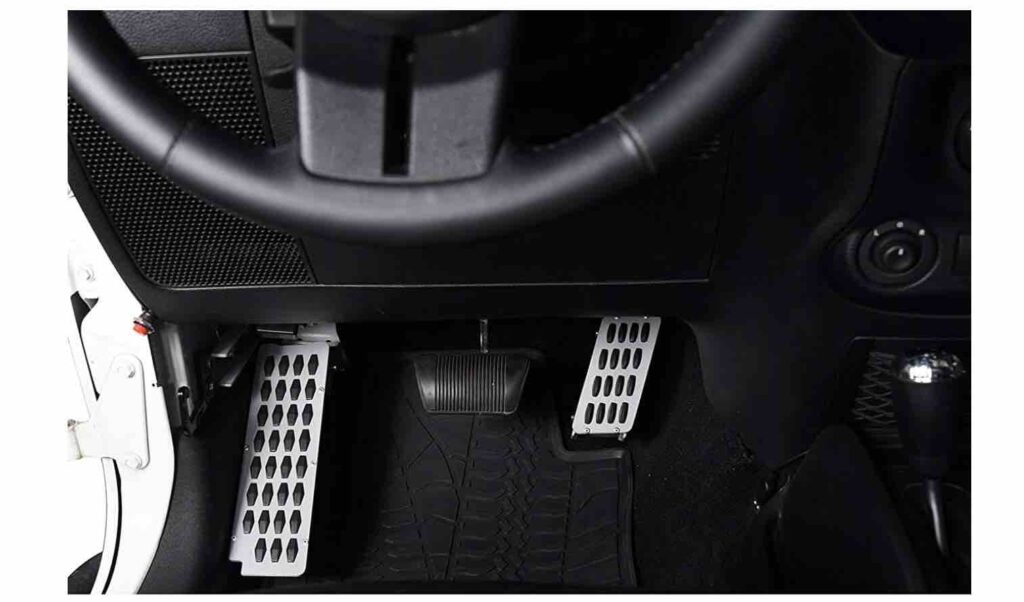
What Are The Gas And Brake Pedals?
It’s good to familiarize yourself with the car’s equipment and controls before starting it. In this section, we will be addressing the two pedals in an automatic car. You can find the gas pedal on the right, while the brake pedal is left. To understand how they feel, lightly press on them with your right foot.
The brake
One of the most critical car controls is the brake. This is a mix of interactive and non-interactive elements. It collects energy from the moving part and uses friction to slow the vehicle down. All vehicles are fitted with a braking system that allows them to come to a complete halt.
The gas
The amount of fuel passed into your engine is controlled by the gas pedal, affecting the vehicle’s speed. The best method is to put pressure on the accelerator with your right foot while keeping your heel on the ground to accelerate.
Is Gas Pedal On Left Or Right?
In an automated vehicle, there are two pedals. The accelerator is located on the right side of the vehicle. And the brake is located on the lift. With your right foot, you control both pedals. When you examine most modern cars right now, they all have the same pedal layout, so we believe it is natural.
As a result, accelerating is mostly an ankle movement, but braking requires the entire leg to be extended. The brake pedals have been raised to minimize unintentional accelerator depression while braking. The brake pedals should be adjusted up as the braking material wears away.
Is Brake Pedal On Left Of Right?
To use the brake pedal, check the pedal on the left side. The brake pedal is positioned on the floor. It applies the brakes when applied, slowing and stopping the car.
To activate the brakes, you must apply force to the pedal with your right foot while keeping your heel on the ground. If you have normal brakes, the pedal will move slightly before resisting. When using power brakes, you don’t have to apply as much pressure to the pedal.
What Is The Gas Pedal Knee?
Excessive pressure and poor posture are the main causes of gas pedal knee issues. When you stand, walk, or run, your right foot may begin to point farther outward than your left foot if you consistently employ poor placement for that pressure. It might put pressure on your knee if this occurs, resulting in muscular imbalances and discomfort.
You are more likely to develop gas pedal knees if you spend a lot of driving. People often become tired of putting their foot back and forth between the gas and brake pedals, so they leave it on the floor and twist it outwards to press the gas. Standing or walking might cause the foot to point outward, putting pressure on the knee, leading to pain and muscular imbalances.
Why Is Gas Pedal Loose?
In some cases, some gas pedals feel loose because they are designed to be loose. That means your car’s gas pedal is inherently softer than others, and pressing down on it doesn’t need a lot of force or effort on your behalf.
This is frequent in manual car accelerators, as some individuals prefer manual transmission automobiles to their automated versions. However, there are times when the gas pedal is a little too soft for your liking since the accelerator mechanism is malfunctioning. If the accelerator wire is too loose, this can happen. You’ll notice that the vehicle responds slowly when the accelerator cable is too loose, and the pedal may be a little too mushy.
How To Tighten A Loose Gas Pedal
Follow the steps highlighted below to learn how to tighten your loose gas pedals.
1st step
Checking your vehicle’s hood, look for the braided accelerator cable on the engine compartment’s right side. On the cable, there are two lug nuts. The lock nut is nearest to the front of the car, while the deflection-adjustment nut is at the back.
2nd step
The next step is to fine-tune the lock nut to your liking. With the use of a wrench, this is simple to accomplish.
3rd step
Turn the deflection-adjustment nut until the deflection in the middle of the cable is between one and three millimetres; the cable’s deflection is the distance it bends in response to the tension deflection adjustment nut.
Why Is Gas Pedal Unresponsive?
The gas pedal can be unresponsive for several reasons. The most typical cause of an unresponsive gas pedal is faulty throttle cables. The cause of the problem will also be determined by the type of vehicle you own and the system that controls the throttle body.
Either a cable or electronics can control the throttle body on a car. If the pedal is operated by a cable and feels stiff, rust on the spring or cable that causes the pedal to return could be the cause. The throttle cable may be the source of difficulty pressing down on the gas pedal. A kink in the cable or a cable that hasn’t been properly adjusted to maintain the proper pressure could be the problem.
My Recommended Gas Pedal Extension For Short Drivers On Amazon
Are you looking for the best car gas pedal extenders? This list’s car pedal extenders are composed of high-quality, long-lasting materials. They also have changeable settings to ensure that they are tailored to your unique height. This section will look at the top 5 pedal extension for short drivers on amazon.
1. Aramox Car Accelerator Pedal Pad
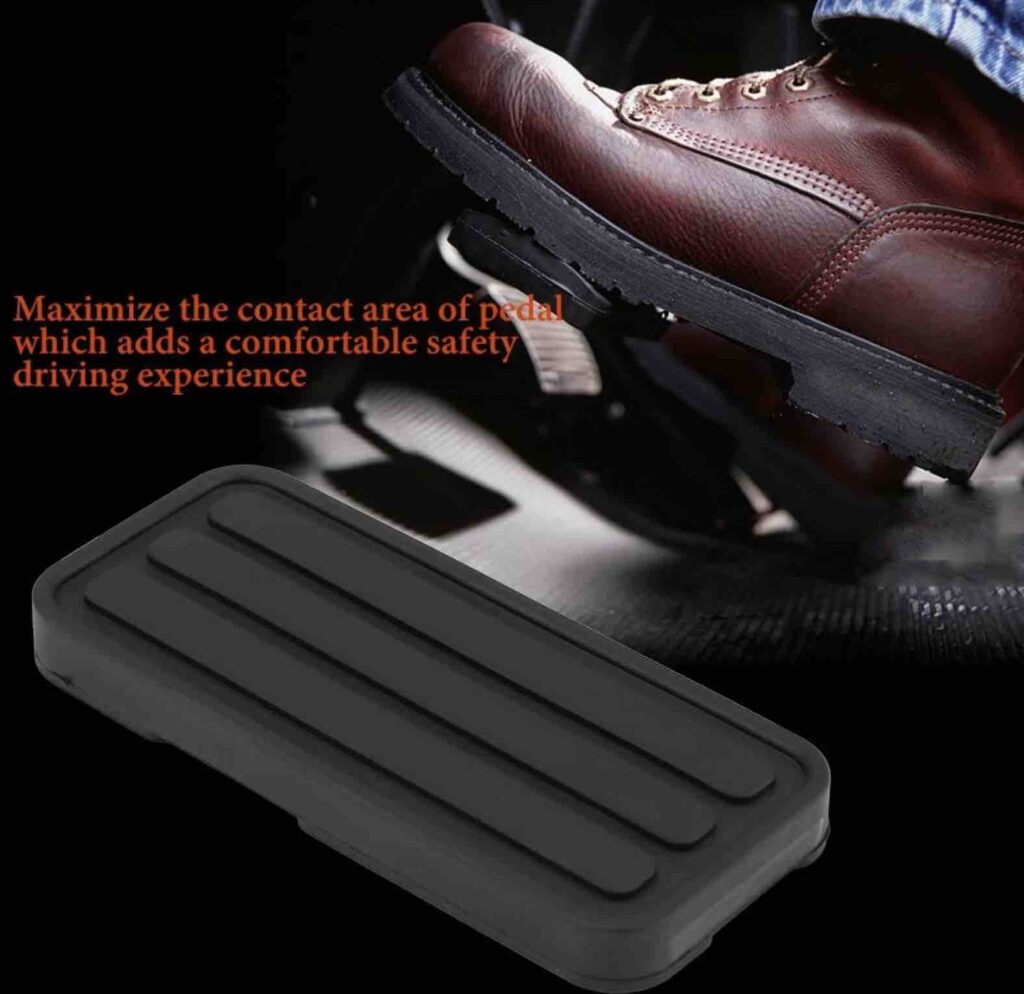
Price: $9.70
This axle rubber pedal pad is composed of automobile-grade thermoplastic rubber for excellent toughness and abrasion resistance. This item is a pair of great quality aftermarket replacing accelerator gas rubber pedal pads. For more pleasant and safe driving, you can increase the pedal contact area. This accelerator pedal pad is built to OEM specifications and can be used to replace a broken or damaged brake pedal cover. This pedal can be purshaced at this Amazon store.
Amazon link:
2. U-Box JK Wrangler Gas Pedal Extender
Price: $22.99
This item is composed of high-speed steel that is of the highest quality. Its polished smooth surface will not rust or corrode, even on rainy days. When you’re treading, you may easily modify the gas pedal height.
With this product, you may improve safety by keeping your body close to the vehicle’s steering wheel and reducing the weight of the accelerator pedal to improve comfort. The lowest and maximum adjustable heights are 2.1 and 2.9 inches, respectively. You can easily tailor your choices to fit the body types of different drivers. You can buy this pedal here at this Amazon store.
3. V8 GOD Gas Pedal Extender
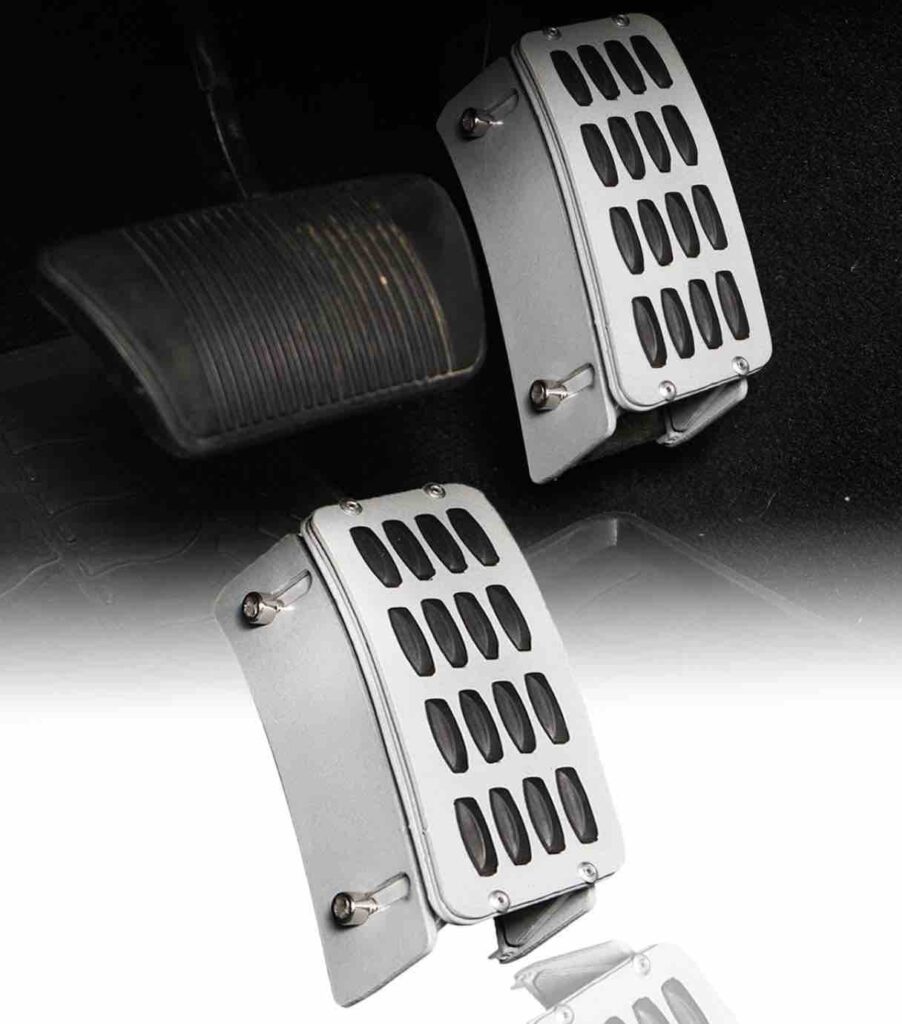
Price: $26.99
This Gas Pedal Pad is compatible with Jeep Wrangler JK Unlimited Sahara Rubicon Sport Freedom models from 2007 to 2018. It’s composed of lustrous quality high-speed steel, which resists rust and corrosion. You can easily adjust the gas pedal by treading to fit your height. This product improves driver safety by keeping the body close to the vehicle steering wheel and reducing the weight of the accelerator to improve comfort. Get this here on Amazon.
4. Hooke Road Gas Pedal Extender
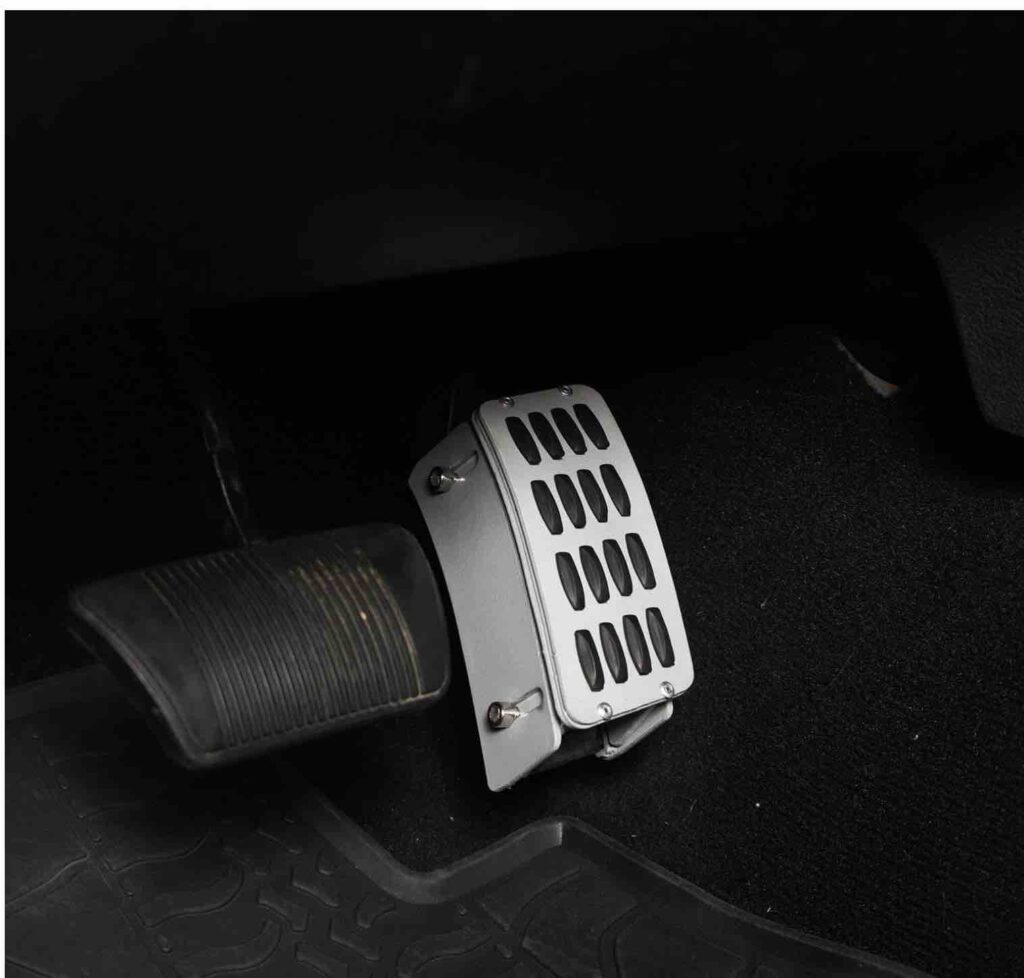
Price: $24.99
The Hooke Road Gas Pedal Extender has been compatible with Jeep JK Wranglers from 2007 to 2018. Multiple rows of anti-slip particles are embedded into the steel cover surface to help prevent foot skidding, especially in wet and snowy conditions. The anti-slip layer is on the bottom force layer of a two-layer surface. To put it another way, if the anti-slip layer wears out, it can be replaced. Here is where you can buy this brake pedals.
5. Hooke Road Dead Pedal + Gas Enhancement Extender
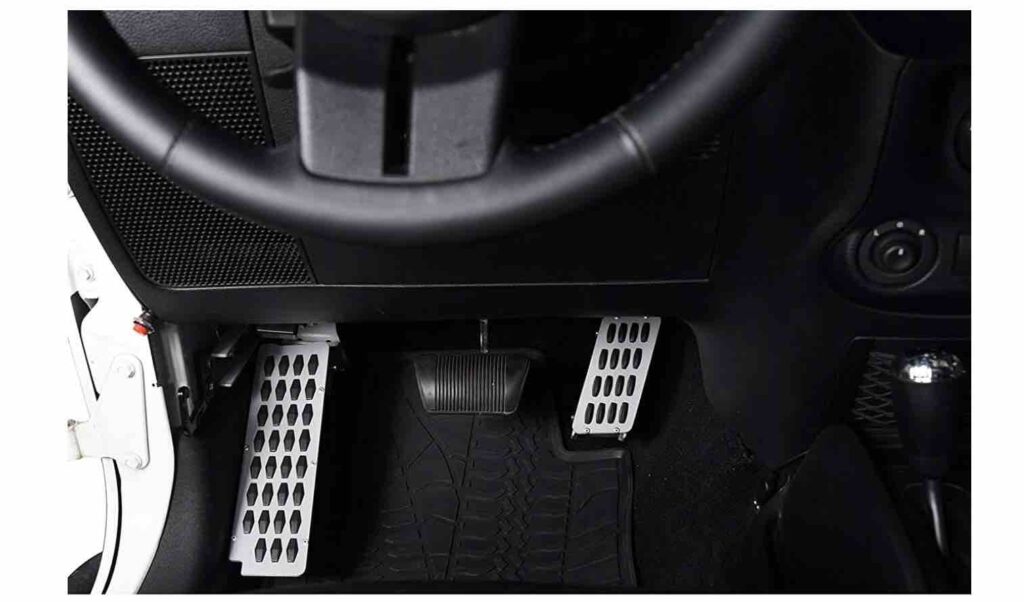
Price: $42.99
Last but not least is this amazing product. This gas pedal extender is also compatible with Jeep Wrangler. It is designed to adjust the gas pedal height while treading easily. The lowest and maximum adjustable heights are 2.1 ands 2.9 inches, respectively. You can purchase this Pedal here on Amazon
FAQ:
Where is The Brake In A Manual Car?
The brake is the middle pedal. The accelerator is accessed by pressing the right pedal. The clutch is operated with your left foot, while the brake and accelerator are operated with your right.
Why Does My Gas Pedal Vibrate?
There’s a strong possibility your car has an exhaust leak if the gas pedal vibrates. As dangerous fumes escape through a small crack or hole, the entire vehicle will vibrate, but the sensation will be most noticeable in the gas pedal as you speed up.
Which Pedal Is Brake And Accelerator In Automatic Car?
In a nutshell, an automatic vehicle has two pedals. You’ll find the accelerator on the right, and there is a brake on the left. The right foot is in charge of both pedals.
When starting a car, do you need to press the accelerator?
The accelerator pedal is not required for starting a car. Onboard computers regulate the engine when your car is turned on, and optimum fueling is automated.
What’s the location of the accelerator?
You can find it on the right-hand side of the floor pedal. The throttle, often known as the “accelerator” or “gas pedal,” controls the engine’s fuel and air supply.
What’s the deal with my accelerator not working?
Your engine will not get enough fuel if the fuel filter on your vehicle is dirty or blocked. This can cause issues with your vehicle when attempting to accelerate. A clogged air filter is another possibility. A clogged air filter prevents the proper air-fuel mixture from being delivered, resulting in slow acceleration.
Conclusion
The gas and brake pedals are important parts of a vehicle, especially when carrying out the core function of movement. As a new driver, familiarizing yourself with the core details that include these parts is very important. Has this article been of help? Let us know in the comment section.

Hi dear, my name is Jeffery Ekweghi, and I am a certified mechanic and autobody parts technician. I created this site to share my expertise and experience with car lovers looking to resolve their car-related issues. I am certified in private cars and heavy-duty commercial vehicles. I have worked as a mechanic since 2015 and have experience in vehicle brands like Subaru, Jeep, Toyota, TATA, BMW, Mazda, Honda, Nissan, Kia, TVs, and Others; however, I primarily specialize in Toyota vehicles.












